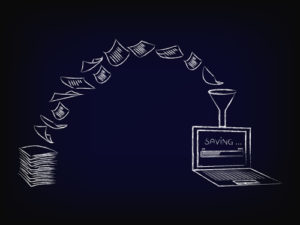With nearly all higher education students using electronic devices to manage their day-to-day life on campus, including uploading assignments to their ePortfolios and managing their course schedules in the institution’s portal via the student information system (SIS), the digital life has become the de facto replacement for paper and pen. Further, students’ expectations—particularly the Gen Z crowd—to manage all of their needs online has led senior institutional leaders to re-examine their processes, chiefly the back office or administrative tasks, enabling self-service capabilities and offering the next generation of paperless functionality.
Implementing new or expanding the use of existing technologies, such as enterprise content-management tools that provide access to e-forms and reduce paper processes, can yield increased efficiencies and productivity, and offer value that improves the overall student experience.
The student-facing side of paperless administration
As universities offer more and more varying degrees, access to financial-aid assistance, and continuing ed or life-skill courses, the sheer volume of paper and document management can be overwhelming. From admissions and financial-aid applications to change of major and transcript requests, students can access, complete, and collect required documents and signatures seamlessly. By offering online self-service pathways to bureaucratic chores, institutions can reduce lost or error-ridden paperwork, benefit from detailed audit trails, and eliminate manual-processing bottlenecks.
(Next page: The need to extend self-service functionalities)
Take, for instance, an enrolled BA student considering a master’s degree who needs to apply for financial aid. On many campuses, the student still needs to carry the applications to the registrar and financial aid office and obtain hard copies of transcripts, all with little insight into where their application is in the process cycle once applied. By combining the capabilities of an SIS with the functionality of an enterprise content-management solution, students can be automatically apprised when an application is incomplete, requires further documentation, or signatures are accepted.
Recently, Middlesex Community College in Lowell, Mass., deployed an electronic forms and workflow solution to let students and administrators access, track, and complete web-based e-forms from any device, significantly decreasing time to completion and increasing efficiency. Expanding existing technologies or implementing new ones that work in conjunction with the college’s SIS will help further the community college’s mission of increasing the persistence, retention, and completion rates of its students. The solutions must be responsive, able to easily integrate with existing technologies, and scalable to meet student growth and peak times for requests.
Reaping the benefits of technologies that can extend self-service functionalities also includes university employees, making the business of running the institution that much easier. Whether submitting personal information for updating payroll requests, expense-reimbursement forms, or vacation time slips, using ECM and ERP systems to allow for self-service capabilities eases the burden for both admin and employees.
Security and privacy of self-service
Surprisingly, many senior institutional executives are still cautious of technologies that offer a paperless experience due to the lack of access to the physical documentation. However, using the functionality through content management and e-forms is a far more secure, efficient process that lends itself to a detailed audit trail of all student documentation.
For instance, students are required to authenticate themselves via a log-in either through the institution’s central portal or directly via the app to begin or complete a form. Once complete, data captured is automatically pushed back to the ERP and the form is processed through predetermined workflows and finally stored to the electronic student file in one central repository, accessible only to pre-designated departments and authorized users.
Even emailing electronic documents outside of an unsecure system can lead to privacy and security challenges for the institution and does not allow for a detailed audit trail.
The “do good” culture
Today, more and more campuses are incorporating philanthropy and social innovation into their gen ed mission statements and culture overall. A large part of that is the student’s impact on their community—locally and globally—particularly their environmental footprint. By adopting new, more efficient technologies that, more important, can reduce the environmental impact of paper, self-service applications can support the institution’s overall mission as a social higher-ed leader.
In the end, increased student self-service functionality leads to a more positive campus experience and cuts down on the back-and-forth administrative tasks, allowing the student to experience what they enrolled for—a high-quality education without the distractions or stress.
- 8 top trends in higher education to watch in 2024 - April 16, 2024
- Defining a path to equitable AI in higher education - April 12, 2024
- Leveraging AI-driven edtech for continuous improvement in higher ed - April 11, 2024

